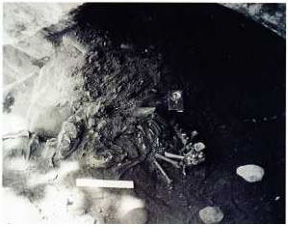Japan’s Oldest Jomon Dog Burials |
||||||
Analysis by several institutions produced a radiocarbon date corresponding to the latter part of Initial Jomon to the beginning of the Early Jomon period (ca. 7,400-7,200 cal BP). Morphological observation of the bones revealed that the size of the two dogs correspond to “small” and “mid-sized”, respectively, as classified by Kotondo Hasebe*1, and had largely the same phenotypic features as what is conventionally known as the Jomon dog. Ancient DNA and stable isotope analysis of the bones were also carried out, yielding fascinating results. No specimens of dog bones in a buried state dating back to the Initial Jomon had previously been found: this includes the mandibles excavated at the Natsushima shell mound in Kanagawa Prefecture, formerly known as the oldest dog bones to be excavated in Japan. Furthermore, in addition to the fact that this was the first time absolute dating of bones from the bones themselves was attempted, the discovery of dog bones dating back to before the Early Jomon in which the features of the entire skeleton can be discerned is of enormous significance. The results of such multifaceted research will provide important clues to unraveling the phylogeny of canines and people that lived on the Japanese archipelago in the Jomon period and the historical relationships between them. (*1) Hasebe K. (1952) Dog bones, in Yoshigo shell mound: Buried Cultural Properties excavation report #1, pp. 146-150. Tokyo: National Commission for Protection of Cultural Properties [in Japanese] |

